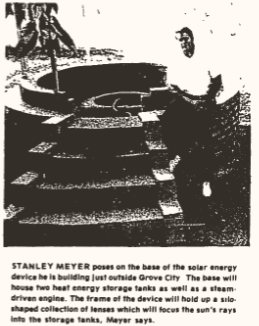Solar Energy Project Near Done - July 29th, 1976
By Richard Jonas, RECORD EDITOR
July 29th, 1976
Source: https://grovecity.advantage-preservation.com/viewer/?k=&t=30203&i=t&d=01011901-12312011&m=between&ord=k1&fn=the_grove_city_record_usa_ohio_grove_city_19760729_english_16&df=1&dt=10
 For Stanley Meyer, July 4, 1978, was a disappointing day.
For Stanley Meyer, July 4, 1978, was a disappointing day.
July 4 was supposed to be the day Meyer hoped to project what has been completed 12 hours a day, six days a week since February in a project which will, he hopes, save his country—that’s quite a statement.
Meyer is installing a solar energy system at the home of Mr. and Mrs. Charles Hughes, 2222 Marlane Drive, just outside Grove City. Meyer hoped to finish installation of the patented product, a Solar Panel Electrical Power Generation System, which will, he says, provide free energy for the home, both heating and electricity.
However, Meyer said, progress on the system has been slow, the rains causing delays, thus he was unable to finish installation of the energy system by the planned demonstration for this past Tuesday. Meyer said he expects completion in "about 10 days."
Meyer, who is passionate about solving the energy crisis facing the United States, says his system uses the free solar energy and could stabilize the nation’s economy. "I love my country," Meyer says, and his work is a contribution to "free world citizens."
However, Meyer, 35, said his revolutionary conservation of the use of solar energy alone "is a success and demonstrates that it can produce electricity, heat, and hot water. If I am done or not, I will have done my part," he said. "From here, I will need the support of the American people to get this (system) going."
"Call in America."
Meyer said he will "call on all American citizens to go to the federal government and support him in his quest to bring forth this answer to the existing regulations which would prevent the utilization of the system."
This appeal to his fellow citizens for support is the basis of Meyer’s plan. "It has always been the free individual," he says, "not industry and not the government which has solved the nation’s problems. This is the story of God, country, and the American way of helping one another.**
"This is a story of American people going to the government to help save it." Meyer said he began contacting companies and individuals to invest in "without a dime in my pocket." Small businesses donated materials, labor, and time to help him, Meyer said. His "Weekend Warriors" who descended on the Hughes property to help with the work.
The project, which was begun in February, is 80 percent complete. Meyer is hoping to finish the final 20 percent of the manufacture of the system within the next two weeks.
After Meyer had engineered the system, the Hughes family, who donated their land to the project, has become enthusiastic about the results. The frame of the device for the demonstration model, he said, is a modular unit that can be erected and torn down as needed.
Meyer said the solar energy device would generate $10,000 to $20,000 in energy cost savings over 10 years. The system could save homeowners $50,000 to $80,000 in energy costs over 20 years if installed nationwide.
Energy is an obsession to Meyer
Highly energetic himself, as well as an enthusiastic, articulate, and impassioned, he is deeply concerned about the energy situation facing the country, a threat he parallels to the threat of World War II.
"That’s why I went down to my basement in July 1975 and researched and developed this system," Meyer said. "I made a simple prayer to God to help me develop the system and it was answered. And my whole goal is to get this energy source to every man, woman, child, and business in the United States."
"Sun energy is a free source of energy which can strengthen the United States and give the small businessman independence so he can maintain his business as well as his home site," Meyer continued. "There's enough solar energy there for everyone to use."
 Solar Project Nears Completion
Solar Project Nears Completion
Manufacture of synthetic material from hydrogen gas burns through oxygen, Meyer said. That gas which uses hydrogen to power automotive appliances is added.
The base of the system—when finished—would be built from an eight-foot by six-foot deep steel tank containing a heat storage cavity designed to store heat overnight in turn drive a steam piston engine which will generate electricity via an alternator.
A second chamber below the first stores heat for the home and hot water heating.
10 Feet Lens
The metal lens frame, the most prominent part of the structure located adjacent to the Hughes home, is the basis for a lens 21 feet high and eight feet in circumference which collects sunlight regardless of the sun's position during the day and focuses it down onto a flat, disc lens, Meyer said. This lens then concentrates the light like a magnifying glass into the storage tanks.
The plastic wall lenses will focus onto the silo-shaped unit at the system and will be made up of a 1,200 smaller interlocking plastic "friction guide panels." A plastic panel was ready to go but was said to be too expensive for Meyer’s model, he said.
Meyer is looking for backing from manufacturers to charge him $27,000 for manufacture of a single 40-inch thick panel, adding that his home model will cost around $30,000. He added the frame, like the design panels, will stand indefinitely and has weather-resistant rubber sealing the synthetic lens.
Soon after the system is demonstrated, it will be ready for mass production, Meyer said. Models from the size of an industrial greenhouse to residential commercial panels will be manufactured to provide energy for commercial and industrial plants as well as manufactured. The modular design of the system makes it possible for it to be put into any economy in all sizes immediately, Meyer said.
Meyer holds the fastest patent ever issued for an energy device in the system. The aid and those experts at the U.S. Patent Office wouldn’t have issued it if it hadn’t been based on proven technology, Meyer said.
Meyer Improves
Meyer became less passionate once he spoke. Behind the scenes lay mechanical technical obstacles that inspired his system.
The former retailer of truck parts, who "walked away from a million-dollar-a-year business to work on the energy system," said, "The history of the present energy system supply and demand dictates that it be tied to the industrial backbone of this country which is nearly broken through by energy shortages."
After Meyer had engineered the system, the Hughes family helped him with further development and more years’ worth of support.
Meyer estimated today that a statistic of 91 percent of today’s oil will go to U.S. energy needs, with $70 billion projected for 1980, he said.
According to Meyer, these dollars are funneled back into the United States economy through the U.S. bank being funded by the Arab states, he said. The Arab states took out billions of dollars in 1975 alone to invest in the United States economy.
"This declaration is now being made by foreign industries," Meyer warned. Utilization of the new system would stabilize the nation’s economy, Meyer said. "Ninety-one percent of our country’s job will be lost if new energy sources are not put into operation quickly," Meyer added.
